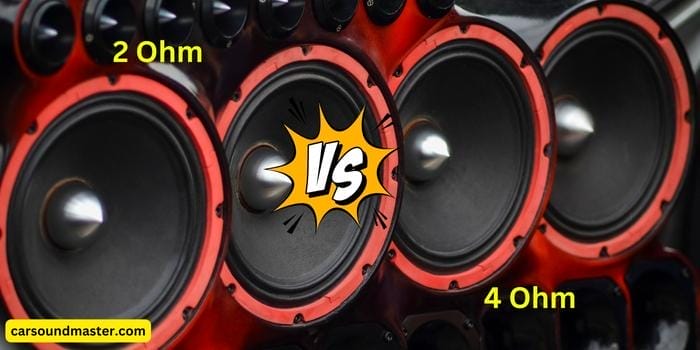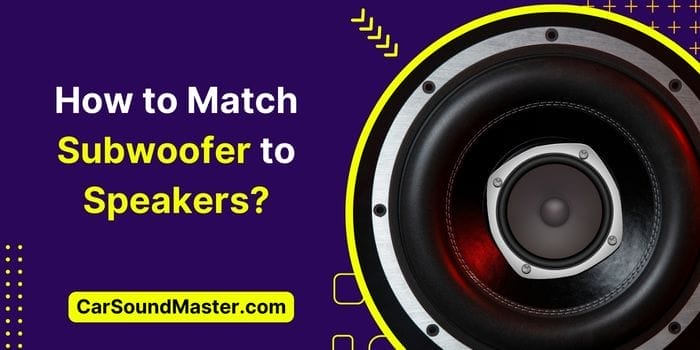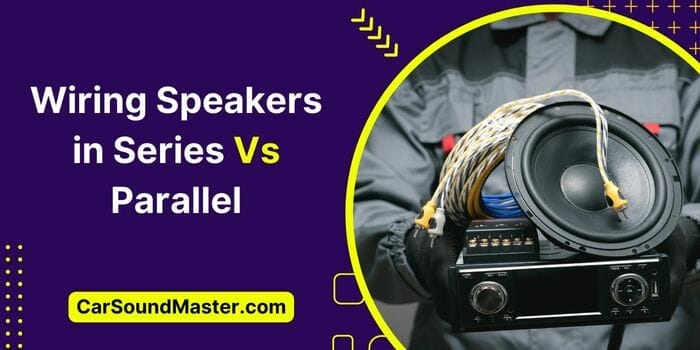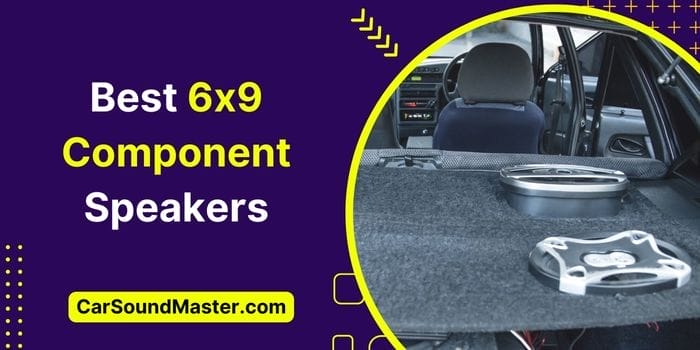2-Ohm Vs 4-Ohm Car Speakers – Here’s Which One to Get!
The difference between a 2 Ohm and a 4 Ohm speaker is the amount of power they draw from the amp or receiver. The more watts a speaker sips, the louder it sounds; the louder the sound, the lesser the sound stability esp. at higher volumes.
Given that, a 2-Ohm speaker will almost always flaunt higher intensity/loudness but poorer quality of sound than a 4-Ohm car speaker.
However, as obvious as anything, before you decide on one from the 2-Ohm vs 4-Ohm car speakers, you should first check out the impedance rating of your car amp or stereo. If the amp is rated at, say 4 Ohms, you can’t ideally go for speakers with lesser nominal impedance than that.
Perplexed? Here’s a detailed guide with everything you need to know.
2-Ohm Vs 4-Ohm Car Speakers
Choosing between a 2 Ohm or a 4 Ohm speaker depends very much on your understanding (and preference) of SPL or SQ.
SPL (Sound Pressure Levels) is the measure of intensity of sound, whereas SQ (Sound Quality) is the measure of how hi-fi, crisp, clear, and accurate the sounds are no matter if they are loud or not.
Given that, if you’re a person who’s just after loudness, go SPL – get a 2-Ohm speaker. However, if you prefer quality and accuracy over intensity, go SQ – get a 4-Ohm speaker. It’s as straightforward as that.
Let’s now see this matter in a bit more detail.
Resistance to Current and Quality of Sound
Let’s explore.
2 Ohm Car Speakers – Louder and Bass-heavy but Unstable Sounds
Impedance, as you may know, is the capability of any electrical appliance to resist the flow of energy (i.e. watts) that’s coming into it from some AC/DC source.
So with 2 Ohm impedance car speakers, you’ve got relatively lower resistance and more power drawn from the DC-powered car amp.
Now, more power draw means more electric signals flowing with ease and the phenomenon ultimately translates into higher projection (i.e. louder sounds) and more bass or punchiness as well.
Though with the same sensitivity ratings and one specified amount of push from the amp, a 2 Ohm speaker will only throw 2 to 3 dB louder sounds compared to a 4 Ohm speaker – which is barely perceptible, anyway.
Well, with the higher number of watts easily barging in, there’s also more hiss, whirr, and other electrical turbulences especially when you turn the volume knob up to full.
All these unwanted noises (at higher volumes) result in poor quality, unclear, and shaky music making your musical ME/mos downright dissatisfactory.
So, next time you hear someone complaining “Why do my car speakers sound bad at high volume”, let them know that they might have speakers with lower impedance ratings installed and that this can be one big reason for that.
4 Ohm Car Speakers – Low Intensity but High-Quality Sounds
Boasting a bit higher resistance to the electrical current, a 4 Ohm speaker would generally draw fewer watts and thus output lower volumes.
The dull intensity and calm sounds of a 4 Ohm speaker though are much more definite, clearer, and impactful than the bumpy and unstable louds of a 2 Ohm speaker.
One big reason for this is, maybe, the higher resistance doesn’t allow a wild influx of all raw + well-done electric signals; thus only the apt frequencies pass out to the speakers.
Hence, with a 4 Ohm speaker, all the highs, mids, and lows are more easily readable, and you feel the truest form of frequencies across the whole wide audible spectrum.
Efficiency, Popularity, and Compatibility
Here is.
2-Ohm Speakers – Limited to No Efficacy for Vehicles
2 Ohm car speakers are relatively less efficient and not as widespread or compatible for use in all kinds of vehicles as 4 Ohm speakers. That’s simply because these speakers require more powerful amps to crop up the same way a 4-Ohm speaker does efficiently with any standard car amplifier.
That being said, because a car amplifier is powered through a DC source (i.e. the car’s battery), it cannot compensate for such high power needs. For example, if the amp is rated at 100 watts for 4 Ohm, connecting 2 Ohm speakers means the amp should compensate for at least 200 watts.
So, if you push it to bear the toll anyway, you’ll run into a disaster – the amp will blow away.
4-Ohm Speakers – Perfect for Cars
Unlike the 2-Ohm speakers, 4 Ohm is the standard resistance used in cars. Thus 4-Ohm speakers are the norm when it comes to automobile stereo setups. Their power and impedance ratings are so that they make the best fit with the low-voltage DC-powered car amps.
Lastingness and Durability
Let’s find out.
2-Ohm Speakers – Not as Long Lasting
In comparison, the 2 Ohm car speakers have pretty brief lifespans. Their low resistance rating means these speakers will consistently suck more watts throughout their operating hours.
Although they are built to play that way, the 24/7 influx of such high energy may still pose threats to the smaller components therein.
4-Ohm Car Speakers – More Durable
On the contrary, the higher nominal impedance of these speakers makes them hold up well together for quite some long terms. They have not as much pressure on their miniature parts as of a 2 Ohm speaker.
So in addition to being the winner of the “2 Ohm vs 4 Ohm car speakers sound quality” contest, one 4 Ohm speaker, if used with caution, can also ride out multiple 2 Ohm models for the long haul.
Pricing and Availability
Most important.
2-Ohm Car Speakers
The 2 Ohm models of speakers are usually priced higher than their 4, 8, or 16 Ohm counterparts, and for some good reasons. Firstly, they’ve got some absolute engineering into them i.e. their gutsy miniature components that brave out heavy flow of watts constantly through a lifetime.
Secondly, compared to the other versions, there isn’t much competition in the market for these speakers so they are quite not as universal as well. Nonetheless, you can still find them for multiple price points catering to the needs of almost anyone.
4-Ohm Speakers
Because 4-Ohm speakers are always the first-choice GO-TOs for cars of all types, they’ve got a significant amount of competition going on in their specific market. They are also quite popular ones for HT setups as well.
All in all, 4 Ohm speakers are catering to the needs of a relatively larger market portion and thus are available almost universally, and at pretty cheaper prices as well.
Matching Your Speakers’ and Amp’s Impedance is a Must
Just as you think about overhauling your factory stocks, ensure matching up the impedance of the car amplifier/receiver with that of the speakers. You’ll have to make sure your speakers’ impedance is higher than or at least equal to that of the amp.
If your amplifier is rated at 4 Ohms, you should never go for car speakers rated at less than 4 Ohms too. Because if you do, the speakers will eventually tend to draw more power than what the amp can ideally compensate for. And this will result in damaging your amp.
In the same way, if you match speakers rated at much higher impedance (i.e. 4, 8, or 16 Ohms) with a 2-Ohm amp, you’ll eventually damage your speaker(s). That’s because the amp will tend to give out more power than what the speakers can ideally counterpoise for.
In both scenarios, though, you can tweak the wiring of your speakers to increase (wiring in series) or decrease (in parallel) the total impedance and somehow make a match with the amp as we do in wiring in series vs parallel.
So it’s not as much about the impedance of speakers but their match-up with that of the amp or receiver that actually affects the quality of sound in your car or HT.
So, What Hits Harder? 2 Ohm or 4 Ohm Speakers?
Well, the word “hitting harder” can have so many meanings, for example, sounding punchier, bass-heavy, louder, deeper, cleaner, definite, etc. However, as music is a subjective thing and every human being has a unique taste of it, it’s difficult to say which version of the speakers may hit hard at your feelings.
But if we just briefly go over all the merits and demerits of both 2 Ohm and 4 Ohm speakers i.e.
- 2 Ohm speakers produce relatively louder and bass-heavy sounds, but the quality of sound gets poorer with severe distortions as you go up the volume
- 4 Ohm speakers may not be as louder, but they are, without doubt, more clean, crisp, stable, and impactful of the two – no matter the volume level
- The 2 Ohm models have more power suction, and thus, maybe, not as long-lasting as the 4 Ohm speakers due to the 24/7 crushing stress on the miniature parts
- The 4 Ohm speakers are stock standards off the belt for most automobiles these days with universal aftermarket availability as well; vice versa is the case for the 2-Ohms
- The 2 Ohm speakers are a tad bit pricey compared to the 4 Ohm car speakers
We can easily decide that the 4 Ohm version of car speakers is way in front and leading most of the contest. Though as regards the winner, that’s a different story entirely upon everyone’s mindset for music.
Final Thoughts – My Verdict
To wrap it up, I’d name my winner of the “2-Ohm vs 4-Ohm car speakers” contest before adding a few closing thoughts – and the winner for me is the 4-Ohm speaker, any day; any moment. I prefer feeling clear and compact notes out of the speakers anytime over them coming out merely louder.
But if you’re kind of a person who’s always after louder tweets, deeper woofs, and listening to the music at the highest volumes no matter if it’s jittery or what, the 2 Ohm speakers should ideally be your bet.
And having read the article, I’m sure you have already worked out your plans for it.
Have a nice day.







